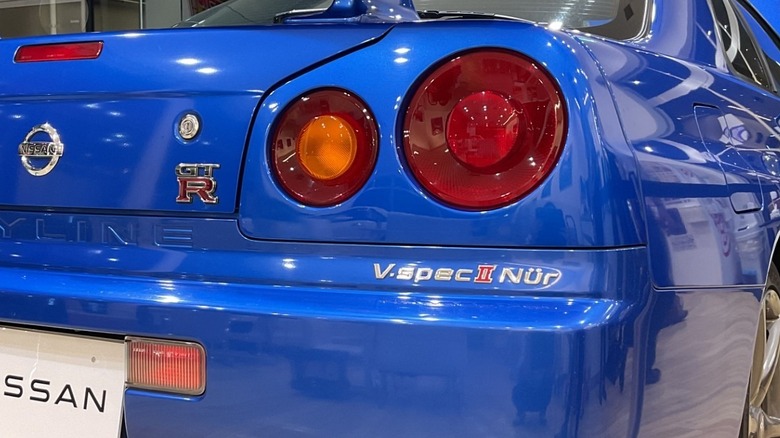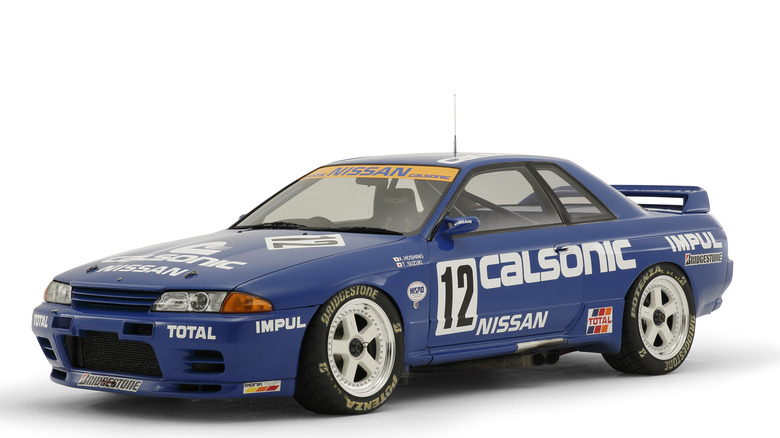What Does V-Spec Mean On Nissan Skylines?
The Nissan Skyline GT-R series needs no introduction among the JDM enthusiast community. Spanning five official and seven unofficial generations if you count the R31 GTS-R and R35 GT-R, this car is the quintessential high-performance saloon of Japan, on par with the likes of the BMW M-series, Ford Mustang GT, and Mercedes AMG. And if there's one thing it's known for more than anything else, it's for tunability.
The car firmly established its reputation worldwide as this humble two-door with a powertrain that took Group A by a storm in the late 1980s, boasting an engine with outstanding capability for producing reliable power. So much so, in fact, that Nissan itself and several official tuning firms produced a huge array of special-edition models celebrating the GT-R's accomplishments and its legendary powertrain. These feature a dizzying array of special designations, but one badge is more commonly found than any other: V-Spec. But what does it even mean? Both literally and in terms of performance differences?
The actual letter isn't arbitrary; in fact, it stands for Victory Spec and was first used on the 1993-1994 R32 GT-R to commemorate the car's Group A wins over the past several years, according to the brochure. To this end, the V-Spec models all feature various performance enhancements over the standard GT-R — as standard as any GT-R could ever be. These generally include various additional extras ranging from lightweight wheels and body panels to high-performance brakes and suspension systems. Let's go over the philosophy behind the V-Spec name and the tangible upgrades each model provides.
The birth of the Victory-Spec
The R32 GT-R was originally developed for winning touring car races at the international level to revitalize the GT-R's reputation, and it proved utterly exceptional at winning races. In fact, the car didn't just win races in Japan — it dominated the entire touring car scene in the early 1990s both domestically and internationally. It's this brutal performance that earned the R32 GT-R the nickname "Godzilla," utilizing its advanced technology for the day to achieve its near-unbroken victory streak. In fact, it won every single Japanese race it entered for four seasons in a row, securing 29 consecutive wins — an incredible feat, not just within motorsports, but any form of sport in general.
Seeing as the car was effectively tailor-made for the track to begin with, there wasn't exactly much that needed improvement over the standard GT-R model when creating the first V-Spec. The main distinguishing features of the V-Spec when it debuted in 1993 were its wheels and brakes: 17-inch BBS rims with 225/50R17 Bridgestone Potenza tires and a Brembo brake package, though it came with other additions like an active rear limited-slip differential.
The following year saw the development of the V-Spec II, which was released on February 14, 1994. It featured few differences over the standard V-Spec, with the most obvious being the wider 245mm tires. Other special-edition V-Spec models existed as well, such as the N1 up to the later R34 V-Spec II Nür, all featuring similarly marginal but generally handling-centric upgrades in line with the circuit racing they competed in.
The spec of a V-Spec
Two other major V-Spec Skyline models existed: namely, the R33 and R34 GT-R V-Spec series. Unlike the R32, the R33 V-Spec featured a marked technological advantage in addition to a handling and aesthetics package: namely, the debut of Nissan's ATTESA E-TS PRO 4WD system, the company's proprietary package for torque distribution on the GT-R platform. What defined it as a PRO versus the standard ATTESA software was that the PRO could modulate the rear limited-slip differential, and it boasted independent rear axle brake management for better traction under heavy braking. Unlike other models, the R33 featured no V-Spec II variant, instead being just the standard V-Spec, V-Spec N1, and V-Spec LM Limited over the course of three major series.
Like the R33, the R34 debuted with a V-Spec trim right out of the gate, releasing with the GT-R itself in 1999, followed by the V-Spec II in 2000, and culminating with the V-Spec II Nür in 2002. The V-Spec and V-Spec II were each produced successively, with no overlap like there was with the R32, however. Much like previous iterations, these featured relatively few changes over the standard GT-R model; however, there were some notable exceptions. For example, the V-Spec housed factory-tuned suspension and an active LSD, and the V-Spec II claimed the title of the first mass-produced car with a carbon-fiber hood from the factory, noted for its distinctive NACA duct on the left-side. To summarize, while all GT-Rs are desirable -– though some might say one of the most overrated sports cars – the V-Spec models represent the top trims of their respective generations without significant modifications.


